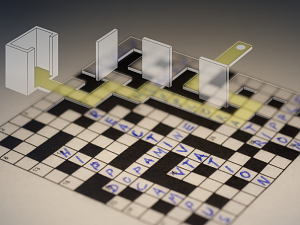 McNamara and colleagues used a crossword maze learning task to show that optogenetic photostimulation of dopaminergic (DA) neurons in the ventral tegmental area (VTA) during exploration can enhance subsequent spatial memory and increases hippocampal sharp wave/ripple-mediated reactivation during rest periods. In the picture the intersection between the hippocampus, dopamine and the VTA are in sharp focus while other details fade out of focus as do memories which are less stable when formed without the action of dopamine within the hippocampus.
McNamara and colleagues used a crossword maze learning task to show that optogenetic photostimulation of dopaminergic (DA) neurons in the ventral tegmental area (VTA) during exploration can enhance subsequent spatial memory and increases hippocampal sharp wave/ripple-mediated reactivation during rest periods. In the picture the intersection between the hippocampus, dopamine and the VTA are in sharp focus while other details fade out of focus as do memories which are less stable when formed without the action of dopamine within the hippocampus.This month Colin McNamara and colleagues report compelling evidence of how rewarding or novel experiences strengthen newly-encoded spatial memories. The hippocampus provides the brain with representations of space (J. O'Keefe and J. Dostrovsky, 1971) but newly-formed hippocampal representations may degrade with time unless stabilized by additional processes.
In this study, the Unit members show that hippocampal sleep reactivation during sharp wave/ripple events (thought important for memory consolidation) can be primed through optogenetic activation of dopaminergic afferents within the hippocampus. These dopaminergic fibres project from the brain’s reward centre in the midbrain, the VTA (ventral tegmental area). Neurons within the VTA are active during exploration of novel environments and learning of new goal locations. They further demonstrated that this optogenetic activation of the dopaminergic fibres within the hippocampus increased memory persistence measured through both behavioural performance and the sustained stability of hippocampal representations of space. These results establish a link through which the brain’s reward system can produce increased memory persistence.
See also the Nature Neuroscience the News and Views piece about this article at http://dx.doi.org/10.1038/nn.3875